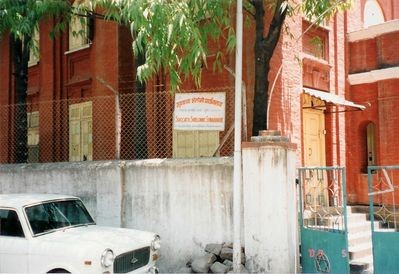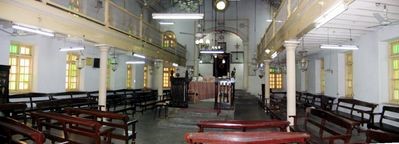SUCCATH SHELOMO SYNAGOGUE (1921)
93, Rasta Peth
(also known as Jew Lane)
Pune
Maharashtra, INDIA
This synagogue, within walking distance of Pune’s other synagogue Magen David, is operational with a small yet active congregation. Pune police are stationed at both Pune synagogues, and they generally do not permit visitors to photograph the buildings or hang around the sites unsupervised. A caretaker is regularly at this building site, so it may be possible to tour it without an arranged visit. Yet for a certain visit, the contact for this synagogue is Oliver Hyams at This email address is being protected from spambots. You need JavaScript enabled to view it., and his telephone number "918378844394".
The Bene Israel (Children of Israel) Jews of Pune initially established four congregations, which for years were operated independently. By 1916, the congregations merged under the name Hebrath Beth Yaacov (Hebrew for House of Jacob) as a prayer hall (generally smaller than a synagogue with less space for communal activities). For a few years, they held prayer services in a rented facility on Rasta Peth. Soon they were able to acquire a building site just nearby for the construction of their own synagogue. This was land owned by Subhedar Major Solomon Balaji Jhiradkar, a local Jew. Work began on the building on 28th of December 1919, and it was dedicated on the 21st of May 1921. Located at 93, Rasta Peth, which is also referred to as Jew Lane, it was given the new name Succath Shelomo (Hebrew for Temporary Structure/Booth for Peace). For decades this synagogue, located in a relatively quiet district of Pune on a pleasant tree-lined street, served a moderately-sized and active congregation. Beginning in the 1950s, as a result of social and political changes, many Bene Israel Jews began leaving Pune, and Succath Shelomo’s membership declined significantly. Nevertheless, the congregation has remained intact and active, and the synagogue continues to operate with regular prayer services. In recent years, the synagogue has been guarded by the Pune police, yet, with permission, visitors may tour the inside.
Set behind a wall and gate, Succath Shelomo’s most prominent feature from the street is its porte cochere, a painted brick and stone arched entrance pavilion located immediately in front of the larger sanctuary building and constructed of the same building materials. This covered area, a 1924 addition, was made possible with a donation by congregant John E. Joseph in memory of his parents, John David and Dinahbai Joseph Borgawker. There is little open space to the front and street side of the synagogue, so a larger area to the rear of the site has been used for congregational gatherings and holiday events over the years. Here are also accessory spaces, including an apartment for a synagogue caretaker.
Succath Shelomo’s porte cochere leads to an anteroom with an office to one end and a stairway to the gallery to the other side. In between these rooms is a pair of doors opening into the sanctuary. It is a rectangular, double-height space arranged according to typical Bene Israel synagogue convention: a centrally-placed raised tebah (bimah or reader’s platform with a table where the Torah is read and the service led) with wooden pieces and brass balusters, long and unfixed wooden benches, a profusion of hanging glass and metal lighting fixtures and ceiling fans. The heckal (ark/cabinet for storing the Torah scrolls) is set in a windowed apse projecting from the end of the sanctuary. In synagogue tradition world over, the heckal, where a collection of large and small Torah scrolls can be stored and seen when the doors are open, is positioned along the wall closest to Jerusalem. Flanking the heckal apse (trimmed at its face, and hence the most decorated part of the sanctuary) are two special cloth-covered chairs: one dedicated to the prophet Elijah and the other for the brit mila, or traditional circumcision ceremony.
The synagogue sanctuary is divided by a classical colonnade into a central nave and side aisles. Above the aisles is the narrow gallery where, according to Orthodox synagogue custom, the women sat separately. One of the sanctuary’s more special architectural details is the woven-metal railing along the face of the gallery. The sanctuary’s plain painted plaster walls are broken by large painted wooden windows with transoms. Hanging from the walls are framed Hebrew prayer verses. Stone floor files and an open-gabled ceiling with exposed painted trusses and joists complete the attractive space.
According to narratives, the Bene Israel Jews were originally ancient traders from the Middle East who for many years conducted business in India. Eventually they settled – perhaps more than two millennia ago – in small towns and villages in the Raigad District within the Konkan Region of coastal Maharashtra. They continued to live there for centuries as a mostly isolated disaporic Jewish community, following Jewish customs while existing among other larger Indian communities. Centuries later, beginning in the very late eighteenth century and particularly during the 1860s, some of the Bene Israel relocated to Mumbai, Ahmedabad, Pune, and Karachi when these British colonial cities were expanding and offering employment and personal opportunities.

Exterior

Interior








